As an amateur scholar and die-hard enthusiast of everything to do with Alice in Wonderland, I have launched a podcast that takes on Alice’s everlasting influence on pop culture. As an author who draws on Lewis Carroll’s iconic masterpiece for my Looking Glass Wars universe, I’m well acquainted with the process of dipping into Wonderland for inspiration.
The journey has brought me into contact with a fantastic community of artists and creators from all walks of life—and this podcast will be the platform where we come together to answer the fascinating question: “What is it about Alice?”
For this episode, it was my great pleasure to have Vice President for Exhibitions and Programming for the New York Botanical Garden Joanna Groarke join me as my guest! Read on to explore our conversation and check out the whole series on your favorite podcasting platform to listen to the full interview.

Frank Beddor
I’m thrilled to have Joanna Groarke on All Things Alice. She’s the Vice President for Exhibitions and Programming for the New York Botanical Garden, which has a fantastic Alice in Wonderland exhibit, Wonderland: Curious Nature, open until October 27. I'm very excited to talk about all the facets of the exhibition. Thanks for coming on, Joanna.
Joanna Groarke
Absolutely. I'm happy to be here.
FB
How did you come to work for the New York Botanical Garden?
JG
I’ve been at the Garden for about 13 years and I've been in my current role for over two years. I've worked in exhibitions and interpretation, which is the development of all of the educational media you see when you visit including signage, audio tours, video guides, and mobile apps, since I started here 13 years ago.
FB
That seems like such a dynamic job because of the diversity of tasks you have and all the different people you get to interface with, especially with this exhibit. You have a lot of cosplayers and musicians. There are the culinary aspects of it. There's the artwork, there are the books, and the library aspect of it.
How was Wonderland: Curious Nature conceived? Where do you start when you're putting together something this massive?
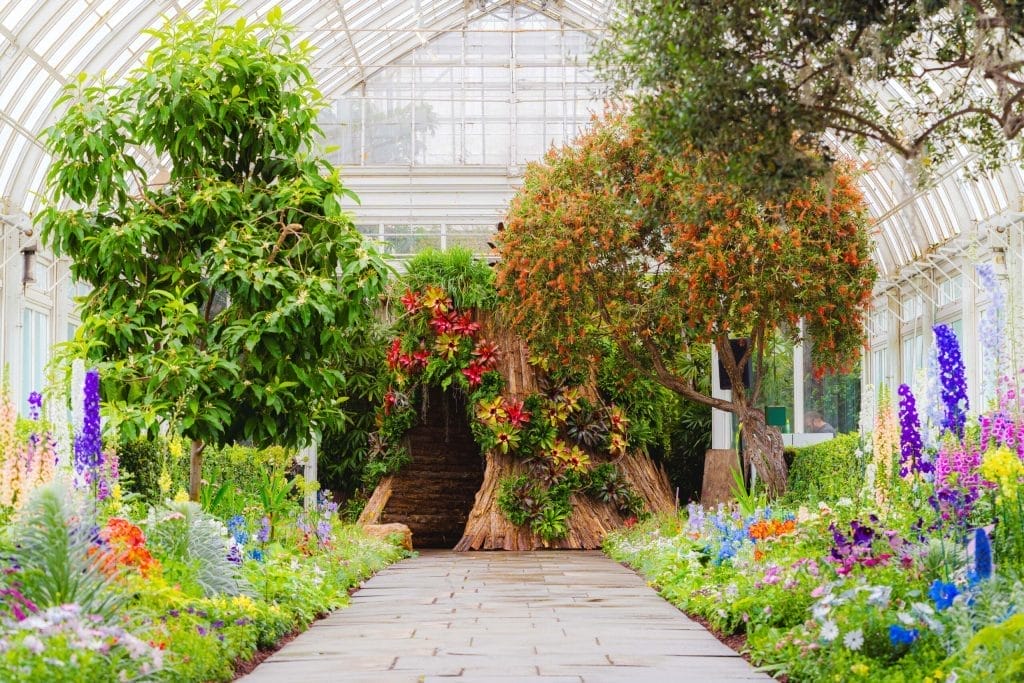
JG
It is a real undertaking. It’s a labor of love every time we create an exhibition, in particular, our summer exhibitions like Wonderland: Curious Nature. These are often original shows we're creating in-house with the help of many, many people, both inside and outside the Garden. We always say good ideas come from everywhere, so sometimes it's a concept that is very closely related to something that's happening in science or horticulture here at the Garden. Sometimes it's something one of us reads late at night when we go down the rabbit hole on some topic and it sparks an idea we then discuss together. In the case of Wonderland, I think for most of the time I have been at the Garden, Wonderland has come up periodically as a topic that's really ripe for exploration through the medium of horticulture because of the connections to science and botany and what was happening scientifically at the time the book was written. Also, so much of the narrative is animated by the setting of gardens and nature. Very early in Alice’s Adventures in Wonderland, Alice looks through a keyhole and sees what she calls the most beautiful garden she's ever seen. One of the things she's trying to do throughout the story is to get into that garden and explore it. That speaks to our hearts also. Our exhibitions are very multifaceted, as you mentioned, but at our core, we're all plant people so we're driven by that interest and our wonder and excitement about plants.
FB
What were some of the plants or flowers that were in the book? You mentioned the exploration of Victorian gardens and some of the vegetation that was in the novel. Was that the starting point?
JG
The plants and the garden settings that are described in the book are part of what first drew us in. One of the things we do with any exhibition like this is, very early on, we develop a plant list. We develop a checklist of objects and historical objects. If we're using the collections of our library, we have the LuEsther T. Mertz Library here at the Garden, which is the world's richest resource in all things horticultural and plant science. We draw upon those collections quite a bit for our exhibitions. We also have the William and Lynda Steere Herbarium, where we have 8 million dried plant specimens that have been collected over hundreds of years by scientists, and we have many examples of those herbarium specimens on display for this show.
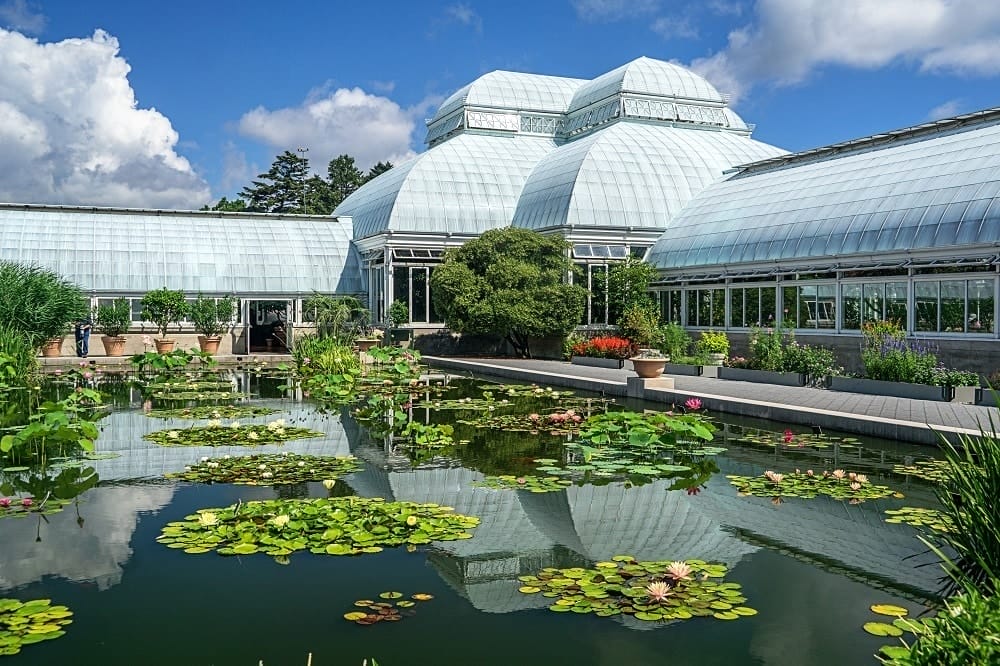
The Garden was founded as a seat of scientific inquiry into the world of plants. Those two resources I mentioned are incredibly vital to the work we do to showcase that research. We were also founded to be a place where beautiful horticulture was celebrated. So my team in exhibitions and programming works closely with horticulture to develop these voluminous plant lists. One of the things we do is mine the text of the book and the images that have been created, both to illustrate the book and then in all of the many film adaptations. So we're noticing which flowers are talking to Alice in the Garden of Live Flowers. We're noticing what plants are mentioned. For example, on page one or page two, I think, Alice is making a daisy chain. We’re making notes all along as we read because that is a great resource for us to know what plants were grown at that time and would have been easily referenced by the author, and then also to start to build what the world of Wonderland, which is what we're trying to do through horticulture.
FB
What's great is that Alice is so deeply seated in culture, you're not just using Lewis Carroll's version, you're using all these various versions. You mentioned looking through the keyhole and that’s from the Disney movie and is not in the original text. I love that you're pulling all of pop culture into this exhibit.
When you enter the exhibit, you are met by an oversized White Rabbit, which has an orangish, reddish, yellowish vest of some sort. I was wondering what flowers those were because it's such a stunning first image. Can you tell us what flowers you’re using and how you keep those flowers alive from season to season?
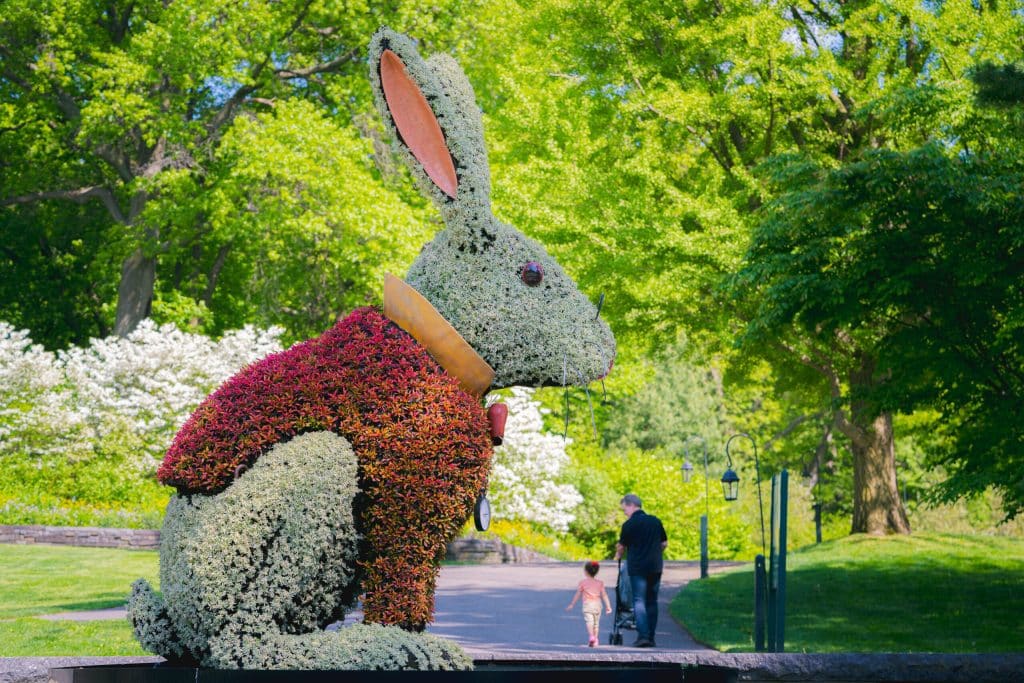
JG
The first rule is that I'm not allowed to touch the flowers. I am not a talented plant person when it comes to caring for plants, but I love them very dearly, obviously, so I work with my colleagues in horticulture.
Our giant White Rabbit is about 12 feet tall and situated in our visitor center. In Alice’s Adventures in Wonderland, Alice’s first sign of Wonderland is when she sees the White Rabbit in his little waistcoat. We wanted to capture that moment when you are arriving and you realize almost immediately you're about to have a magical, whimsical experience at the Garden. We worked with our friends at Mosaiculture, which is a company based in Montreal. They produce these beautiful living sculptures that are based on the ancient art of mosaiculture, which involves creating these beautiful wire armatures that plants are then plugged into. The plants that are most prominently featured on the White Rabbit are a special variety of Sedum that has a little bit of a white tinge to the foliage so it makes him have his little white fur. Then Alternanthera, which is used to create the waistcoat. It has a very sophisticated irrigation system so we can make sure he's looking his best every day when you arrive.
FB
The irrigation system must be a work of art in and of itself.
What about the library? You have the books displayed and the emphasis is on the enduring popularity of Alice in Wonderland. Have you come to a conclusion as to why Alice has lasted for over 150 years in your estimation?
JG
What spoke to me and what spoke to us as we were organizing the exhibition was the way in which Alice feels like this universal heroine. She is a stand-in for the reader, which is not unusual, but was unusual at the time, in particular, for children to see in literature. A heroine who was actively exploring the world around her. Yes, she was subject to the whims and events that adults, sometimes human adults and sometimes animal adults, put into motion. But she also has an impact on the course of the narrative and that wasn’t very common in children's literature at the time. That sense of empowerment and exploration of the world around you is one that really speaks to us and we thought would speak to our visitors. It deeply connects to the way we hope visitors of all ages will experience the Garden. We have a lot of programming for kids in our Children's Garden and our Edible Academy.
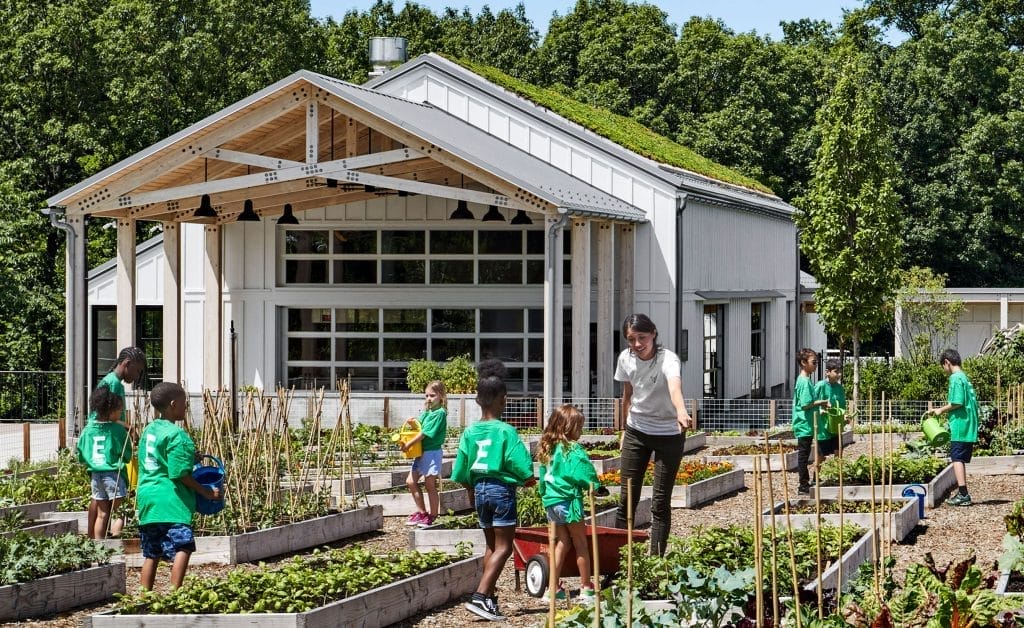
FB
What’s your Edible Academy? Where do I sign up?
JG
It's pretty great. It's one of my favorite spots at the Garden. We have two gardens that are really for children, although, of course, children explore the entirety of our 250 acres here in the Bronx. The Edible Academy is on the site of what has been our family garden for generations, and in 2018 we reopened it as the Edible Academy.
We have classrooms, a greenhouse, and vegetable gardens throughout this space, and thousands of school kids come every year and plant the seeds, tend to them, and weed the beds. Then they learn how to cook with the produce they produce. We have schools that come repeatedly and they see the beds through the full growing season and then get to cook with the produce and bring the produce and recipes home. We have kids who come in every week for drop-in programming with their grown-ups and they get to have a similar experience over the course of the season. Then we do one-off visits where the kids get to participate in the growth, tending, and harvest.
My own daughter has participated in the programs and the camps we hold there in the summertime. It’s a pretty special place. We encourage literally digging in and getting your hands dirty. So someone like Alice feels like she really resonates as a protagonist, who is herself getting involved right away in the events of Wonderland.
FB
When were you introduced to Alice and in what medium were you introduced? Then what was your reaction to that first introduction? There’s the family-friendly, whimsical interpretation and then for other people, it's more nightmarish and a little bit scary.
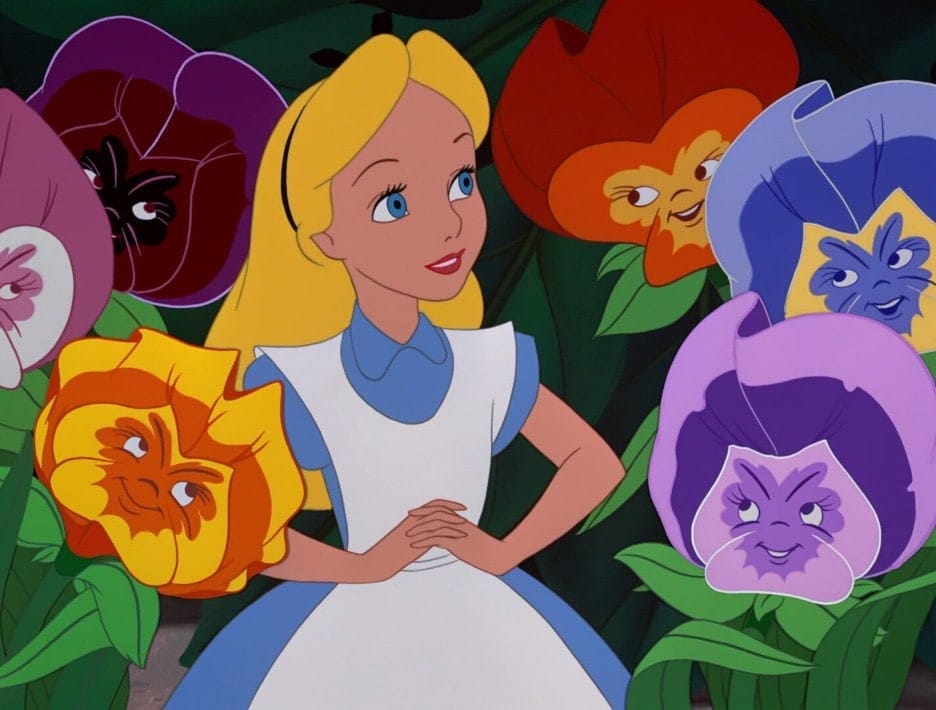
JG
I was a very bookish child. So bookish that when people my age reference things on television, I don't always understand the reference. But interestingly, for Wonderland, I was first introduced to it through the Disney film. But I would have pretty quickly picked up the book after seeing the film. Even in the Disney film, I was struck that it is a little scary. These giant flowers are being mean to her and the Red Queen is pretty scary and I think that is sort of inescapable. Our show is definitely meant to be enjoyed by visitors of all ages, but I think kids are a little bit drawn to frightening stories or the darker side of stories. As a kid, I remember feeling that was part of the story and feeling ambivalent about it. But one of the things that really resonants as I think about the books and the films, as we've been working on this show for the last few years, was how Alice, quite overtly, expresses her frustration with the world of adults and the world of rules that's around her.
It's very relatable. It’s also pretty revolutionary because she is very clearly well-schooled in etiquette and how to behave. The idea that kids both chafe against rules but also are aware of them and understand the structure that exists and they sometimes rely on it, is, in a lot of ways, at the heart of what I as a kid, and probably a lot of kids, find both exciting and a little scary about the story.
FB
Also how illogical adults can be at times with their rules and how they're putting you in this box. I found that to be very relatable as well. When I started working on my Alice projects, it was like if you buy an Audi and then suddenly you see all the Audi's out there. Same with Alice. Suddenly, I noticed “down the rabbit hole” was used in politics and music. Every single day I read somebody saying, “Down the rabbit hole.” So two years ago, when you and everybody on your team started this, did the Alice references and how deeply seated it is in pop culture start to bubble up? For instance, I didn't realize how many people were doing cosplay, whether it was the traditional Mad Hatter or Johnny Depp's Mad Hatter. It's everywhere. Did you guys have a similar insight when you were starting to build this out?

JG
In organizing exhibitions like this, we're thinking about all the ways in which our visitors find meaning around the topic. We talk a lot as a team in exhibitions and then as a broader team here at the Garden that is responsible for the visitor experience. We talk about making sure there are points of entry that allow everyone to have the experience they want to have because that will make what they are seeing resonate more. It'll make them more excited about the plants they see. The cultural expectations and the cultural imagination that exists around Alice are things we definitely talked about and have continued to talk about throughout the run of the show.
We had a feeling we would have a lot of people coming dressed as Alice and other characters, and that was in part because we had seen that with other shows where you might not expect it. Nearly 10 years ago now, we had a show that was focused on Frida Kahlo and her garden in Mexico City, and how the plants she grew there were impactful in her larger artistic practice. We had a lot of Frida look-alikes coming to the show, people who would dress up like Frida and her husband, Diego Rivera. We ended up organizing Frida look-alike contests as a night activity for some of our Frida Alfresco nights.
When we had our exhibition of Yayoi Kusama, the contemporary artist, in 2021, we had lots of people dressed up as Kusama. We had a lot of baby Kusamas in particular, actually. So we knew this was something folks liked to do when there was a show that really appealed to them. We had a feeling that that would happen with Wonderland: Curious Nature. We have some opportunities for people to come and dress up. When people buy a family package ticket to the exhibition at the Garden, they can actually buy headpieces so each member of their party can dress as Alice or the Queen or the White Rabbit. We found that those were snapped up really fast. We had never done anything like that before so we weren't entirely sure how it would do, but it was really popular.
Every time you work on an exhibition, you go in with a plan of what the show will be, and then as you start to have visitors, you make little tweaks and adjustments. We wanted to have opportunities for all of our visitors to meet some of the characters so my team organized that each month we have a different character or characters who are on-site on the weekends. Visitors can take photos with them and talk to them. Right now, we're in the midst of our Mad Hatter month, so we have the Mad Hatter here every weekend. We found that visitors really wanted a photo op as part of that, so we had to think a little bit about how we tweaked that experience. Then, as we were approaching the end of the school year here in New York City, we organized a “Mad for Summer” weekend where we encouraged families to celebrate the start of summer here at the Garden. We had never done that before but it was so much fun. Kids got in for free if they were dressed up in any costume or Alice-inspired garb. We had this weekend of so many fun activities, lots of photo ops, and interactive moments with the characters.

FB
Why don't you give us a little rundown of those entry points? You have things for kids but you also have cocktail hours for adults. There's also food and I've read about a lot of different music. You had a Pride night with Malik Miyake-Mugler. Maybe you can talk about the diversity of the show and some of those entry points you keyed in on early to give people access and variety,
JG
When people hear about an exhibition focused on Alice in Wonderland, they automatically ask what there is for kids and families. But Wonderland has persisted for 150-plus years. It's never been out of print. It's been published in over 170 languages. We knew it was an enduring story for a reason and if a story endures like that, it's not only being consumed by kids. So it was important to us to make sure we had a lot of different ways for people to experience the exhibit. We have an exhibition in the library where you can see some of the original publications. You can also learn about what was happening in terms of science and botany in the 19th century in Britain and around the world. Alice’s Adventures in Wonderland was published just a few years after Charles Darwin published On the Origin of Species, which completely transformed not only science but modern society, in a lot of ways, with the ideas it was putting forth. So, in that environment, a book like Wonderland comes out.
It's also coming out in an environment where there's an increasing acknowledgment of childhood as a different stage of development. Children are not just miniature adults but are considered to have a different way of learning and a different way of seeing the world. That was something we were really interested in because kids know that they're not adults, obviously, and adults know that kids are not adults. But we knew that adults in particular would find that story interesting. The idea that Wonderland is shaped by a lot more than just the desire to create something that entertains children, which is true of a lot of what kids consume. Even today, every show your kid watches has little Easter eggs for adults. The same is true when you're reading stories with your kids. So that was something we wanted to make sure we did.

But also we wanted to speak to the long-term cultural resonance of the story and the ways in which it's been interpreted through the lens of pop culture, through the lens of psychedelics, and through the lens of different artists. One of the things we have is a display of different herbarium specimens of different psychoactive plants and information about how studies of the mind, cognition, and psychology were becoming more and more prevalent during the Victorian era all over the world. The documentation of everything from coffee to cannabis to opium was not just in the scientific realm. The way different writers, doctors, and psychiatrists were starting to write about the effects of different substances on the mind was really interesting to us because that's a modern-day association with the Wonderland stories. While there's no actual evidence Lewis Carroll was partaking in any of these substances, most likely he was not, that association is really interesting and fruitful and has led to a lot of different cultural expressions, from music to the way some of the films and other adaptations have entered the world. That was something we wanted to talk about, especially because most of those substances come from plants and fungi. That's where we have something to add to the conversation because we have the expertise here at the Garden.
We also wanted to invite contemporary artists. We have photographs by Abelardo Morell, where he created these incredible dioramas using illustrations from different editions of the story and then photographed them. We have work by Patrick Jacobs, an artist based here in New York, who creates these beautiful miniature worlds you peer into and it's like peeking into the rabbit hole. The three he made for our exhibition are called Portals for Alice and he was quite overtly inspired by the story.
As we were looking into the contemporary art world, we worked closely with our guest curator, Jennifer Gross to develop our list of artworks we have on view, we became really interested in the work of this group called the FoldHaus Art Collective. They're based internationally and here in the U.S. They've done a number of installations at Burning Man and they created this work called Shrumen Lumen, which is two 15-foot tall kinetic mushroom sculptures. While you're standing outside of our conservatory looking at them, you'll notice that one of them moves and they actually appear to be breathing. They inflate and deflate, and at night they light up with different strobing LEDs in different colors.

FB
Mushrooms are very popular in culture right now and there was an amazing article in National Geographic about all of the varieties of mushrooms. Do you guys explore fungi and the importance of fungi in the natural world?
JG
Mushrooms are definitely having a moment and we are very excited by that. Mushrooms are fungi, so they are not plants, but we do study them here at the Botanical Garden as they are so critical to plant life and environmental health. We have great collections of different specimens we were able to bring out and show visitors. We have organized a Magic Mushroom Weekend, which is taking place September 14 and 15. We’ll have different ways to experience mushrooms, from seeing how they are used in cuisine to how they are used to make dyes and art. There are innovative companies that are using mycelium to create packaging and building materials. Of course, psychoactive mushrooms are also increasingly being studied for their potential to treat all different sorts of conditions. While we will not be offering samples, we are eager for our visitors to learn as much as possible about the many ways in which mushrooms are used and appreciated.
FB
So there's not a rabbit hole you can fall down and try a couple of magic mushrooms?
JG
We do have a constructed rabbit hole, and we would encourage you to fall down it or pass through it in our conservatory, but we will not be facilitating that journey with anything you can consume.
FB
Do you have some Alice in Wonderland Easter eggs in the exhibit that you would encourage visitors to search for?
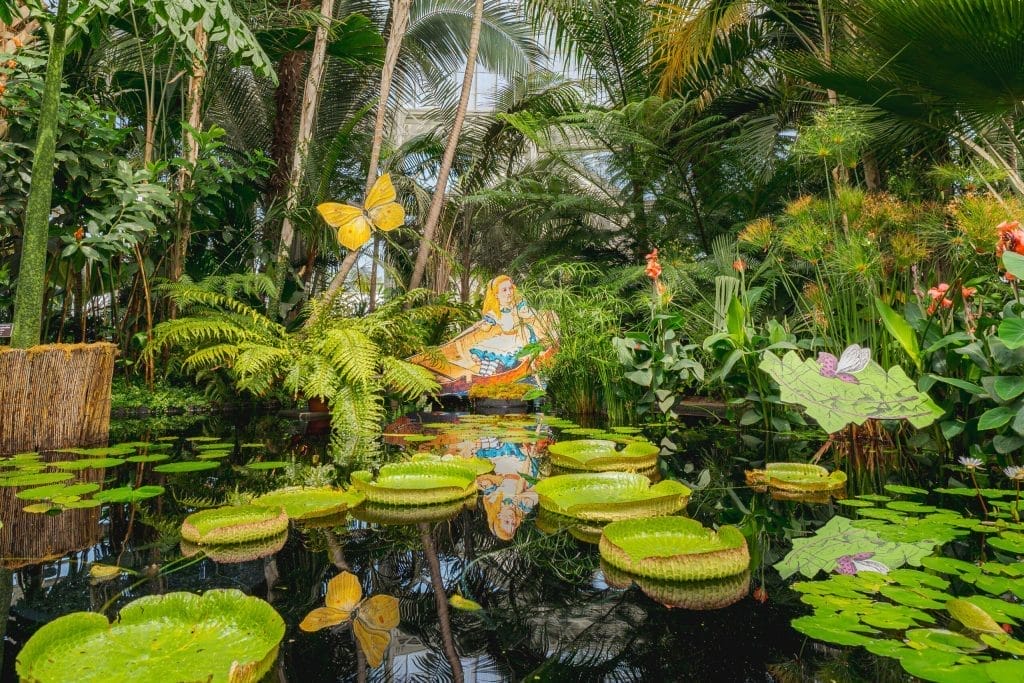
JG
We have different depictions of the characters from the story seeded throughout the grounds and the conservatory. When you first enter our conservatory, you're in a Victorian-era glass house. Ours is among the latest built Victorian-era glass houses in the country, completed in 1902. When you enter one of the first things you see is a a pool of giant water lilies, Victoria amazonica, which were named for Queen Victoria and were a prized specimen plant during the period in which Alice’s Adventures in Wonderland was written. The Oxford Botanic Garden, which would have been where the real Alice Liddell and Lewis Carroll would have seen these plants, was our inspiration for that first entry into the wonders of the plant world and how they figure in the story. Alice is there in a boat among the water lilies, a nod to the boat ride famously associated with the origin of the story.
Then visitors pass through a doorway into one of our exhibition houses and they pass our homage to the Oxford Botanic Garden Flower Border. They actually do pass through what looks like a rabbit hole in the roots of a tree. Then they enter our version of Wonderland, where we have all kinds of wonders of the plant world, from giant tree ferns to carnivorous plants. Sensitive plant is one of my favorites. It's a Mimosa that if you touch the plant, it will curl up its leaves. Not everybody associates plants with having those kinds of abilities.
In our plant Wonderland you can also spot the Cheshire Cat in a tree or the Mad Hatter and the March Hare. We wanted to give our visitors the experience of the wonders of the plant world while also giving them an opportunity to engage with those characters throughout the exhibition.
FB
It sounds like there's a lot for adults because there's the scientific part of it, the educational part, and the historical part of it. Then for the kids, they're going to see this magical rabbit and these big card soldiers. There's so much for them to do. It sounds like it's been really successful in terms of the number of people who have come. Are you guys all very happy with how it's turned out?
JG
It's been it's been wonderful. It's been so exciting to see visitors during the day and also at night. We threw Wonderland parties in June and May when the show first opened and they're coming back in September. They’re nights when visitors can come and dress to the nines as whatever character they like or not and it’s basically a Wonderland dance party. We have DJs and some of the characters on hand. You can dance with Alice and the Queen of Hearts. Those are fabulous and fun. We love to create an experience where someone can come on a mission to see the plants of Wonderland or they can come just to have a good time. That's been incredibly successful and rewarding to see.
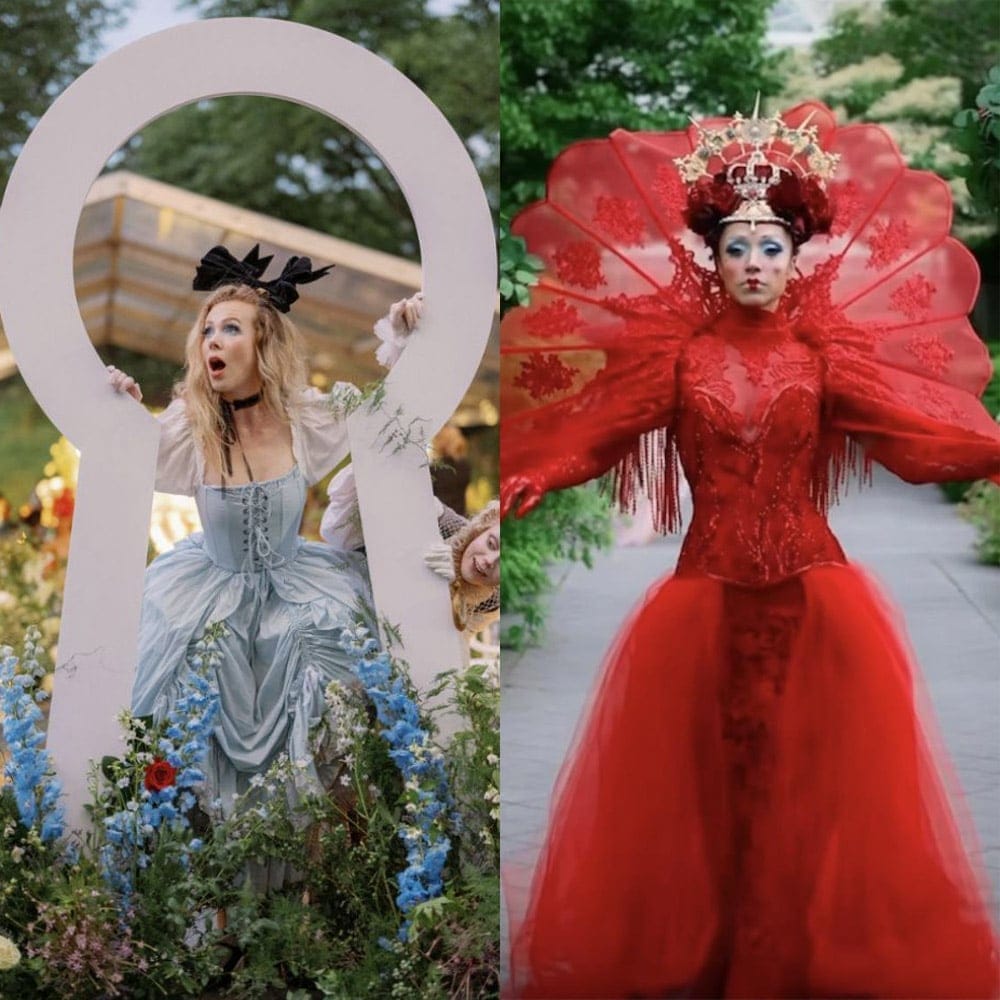
FB
People who love Alice love all things Alice in my experience. No matter what aspect of culture it is, if it has to do with Alice, they're all in. I first met these people at Comic-Cons. They’d walk by my booth and see Wonderland and they would come right over and talk about their book and art collections.
What's been the biggest challenge in pulling something like this off?
JG
Anytime you have an exhibition in a garden, there are certain challenges. One of the big things that my team is always doing is working with artists and supporting them to showcase their work outdoors, which many artists are accustomed to but many are also not. Being mindful of, as you said, the myriad ways that visitors will be expecting to see Alice, and trying to deliver as many of those as possible is a really fun challenge. But it is a challenge because in the 150-plus years since the story first appeared, there have been so many opportunities to imprint on someone's mind what Alice means and what Wonderland is about. That's why working as a team with outside advisors, our guest curator, and everyone from food service to security to visitor services to make sure that the experience we're offering feels as robust as possible is critical.
We have special tea parties that have been held as part of our weekend events but you can also come have a tea party with your family and friends in our cafe. That has been really popular and really special. As we introduce these things, we're planning really carefully. We had a friends and family launch where some of the staff attended one of the tea parties and got to sample the food, give feedback, and think about what that experience was like before the visitors ever stepped foot on the ground. It's all about the planning and the cross-departmental partnerships are really fun and really rewarding.
FB
You have four seasons there in New York. How do the exhibit and the plants change and how do you manage the change from spring to summer and now going into the fall?
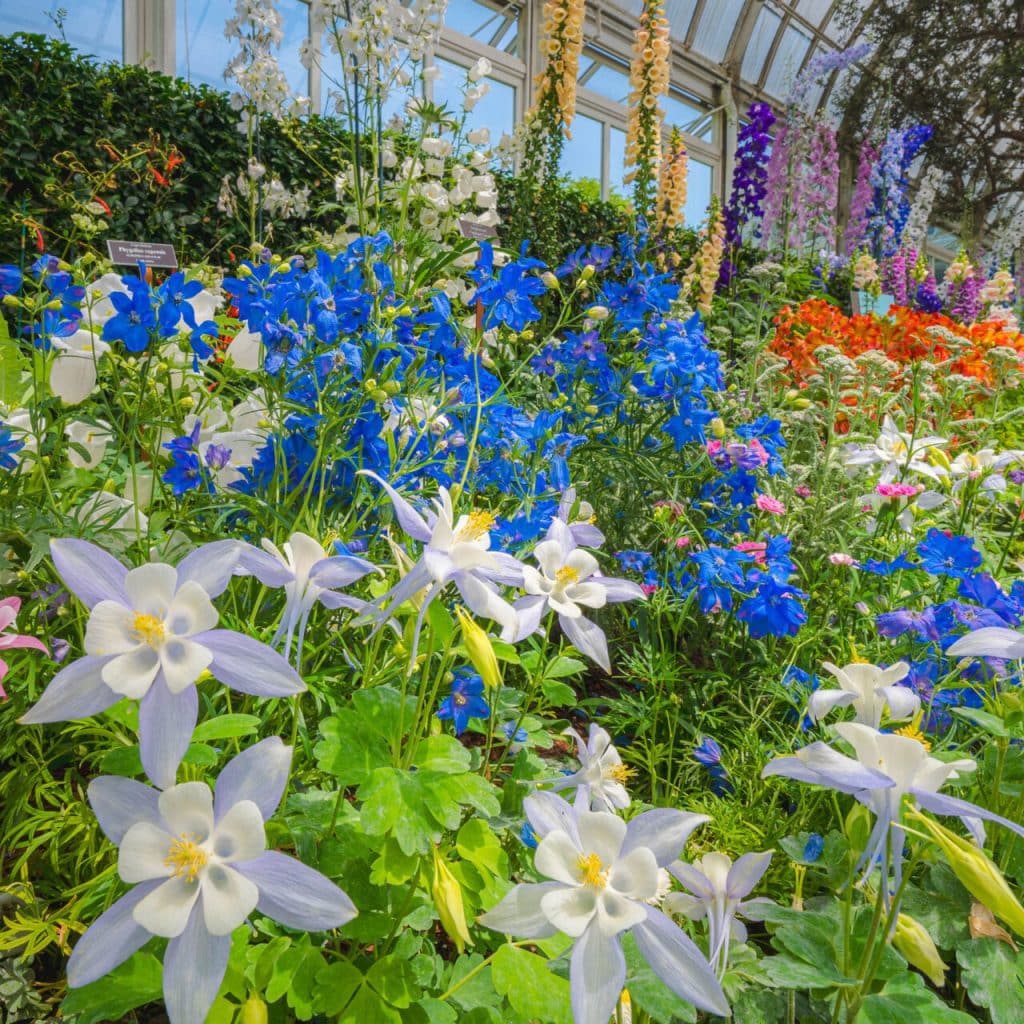
JG
A botanical garden is a dynamic environment. Last night we had torrential rain so we're constantly in touch with each other about what that means for for the garden grounds. We have people here 24 hours a day to keep the Garden safe and to keep the Garden operating. When there's a storm, we're in touch all day and all night. The summer exhibition is really a multi-season exhibition. It opens in mid-May and it runs through the end of October, so you’re really experiencing spring, summer, and fall. The horticulture team at the Garden is incredibly talented and the work they do is fascinating. What they're doing is developing what we call a plant palette, a range of plants that will be on view. They're developing, in many cases, three plant palettes, because what you see in the spring is different from what you’ll see now. In the spring for this exhibition, when you first entered the conservatory, you saw these incredibly beautiful foxgloves and Delphiniums and plants that were very English garden spring in their appearance and style. It was heartbreakingly beautiful.
There were these poppies that were just gorgeous but a few days later, the poppies had wilted because that's what poppies do, and then something else was put in their place. Our staff is here every day, watering and tending to the plants. We're changing plants constantly. We bring things back into the production greenhouse when they've finished their flowering period and either put them into the collections to be used for display purposes when they flower again, or, in other cases, they’re annuals so we're composting them and they come back out around in a different way as mulch and fuel the future plants we showcase. It's an incredible process to see the team caring for these plants every single day, and then on Mondays, when we're closed, that's when the big changeouts take place. It's pretty incredible to see what they can do.
FB
I love your job I like the environment that you live in. I like the people and the excitement of so much changing, day in and day out, just like nature. I really appreciate you taking the time.
I have one last question for you. If you were a character from Alice in Wonderland, who would you be and why?
JG
This was really hard. I knew that this was coming, so I thought about it, which was good because I was struggling. This probably comes from that bookishness I alluded to, and also the work I do now, which is all about making visible what this place is and how it works.
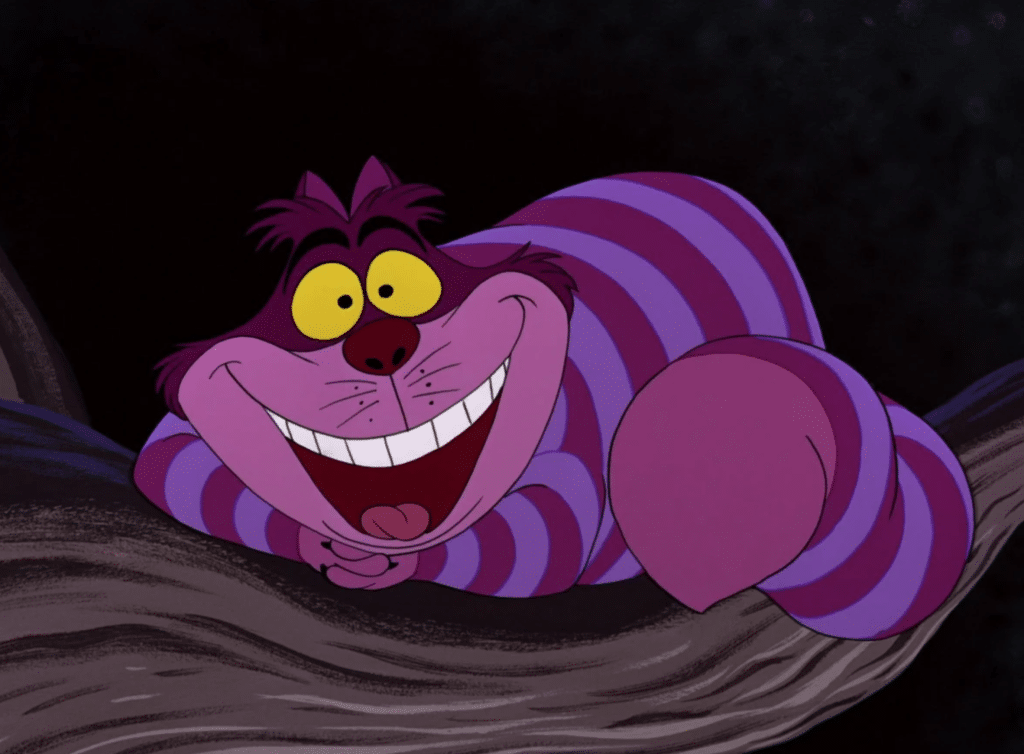
It's probably going to be the Cheshire Cat. The Cheshire Cat has one of the best lines, “We're all mad here.” But also, the Cheshire Cat acts as a guide and helps Alice to make sense of the world around her, and not in a parental way, like a helicopter parent. He pops in, literally, and offers words of wisdom, sometimes slightly confusing words of wisdom, and then disappears and lets Alice figure it out for herself. While we don't want to pop in and then disappear on our visitors, part of the job of organizing an exhibition like this is to create just enough of an environment that is controlled by what we plan and how we lay out the space and what we tell you in the signage, but then to let you have your own experience. So that resonates.
FB
Excellent answer. That bookishness has served you very, very well. Thank you for a very compelling interview. It was great to meet you, and I encourage everybody who's listening, if you have a chance to get to New York before this closes, definitely check it out. Thank you so much. Joanna. Really appreciate it.
JG
Thank you. So nice to meet you.
For the latest updates & news about All Things Alice, please read our blog and subscribe to our podcast!